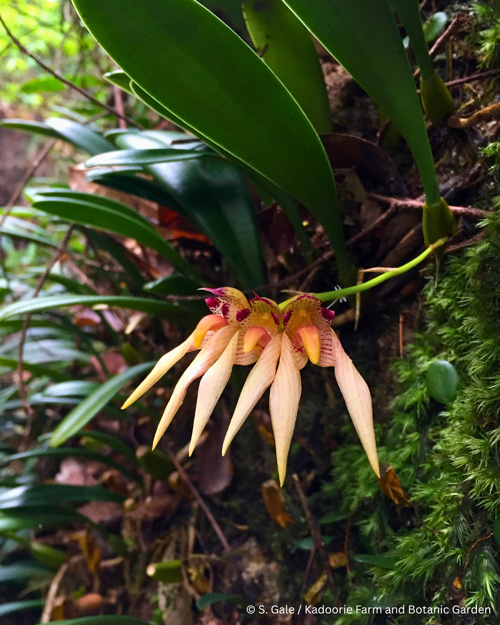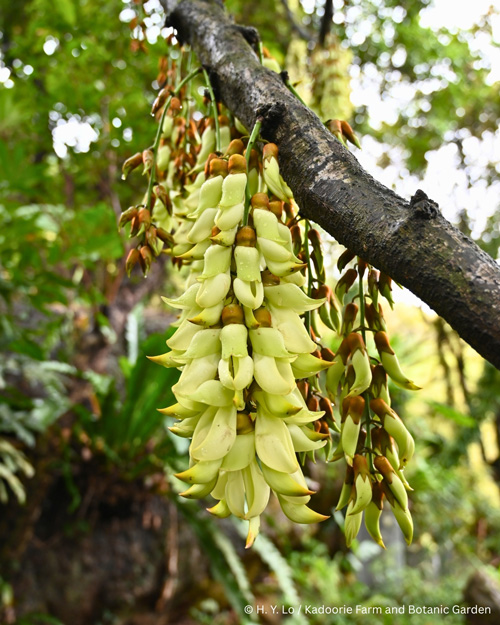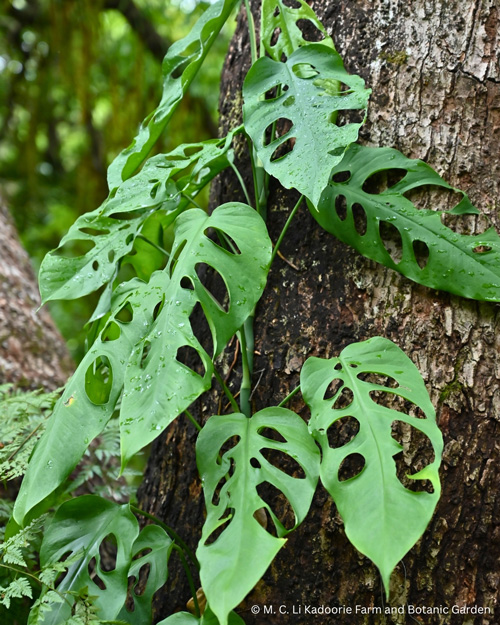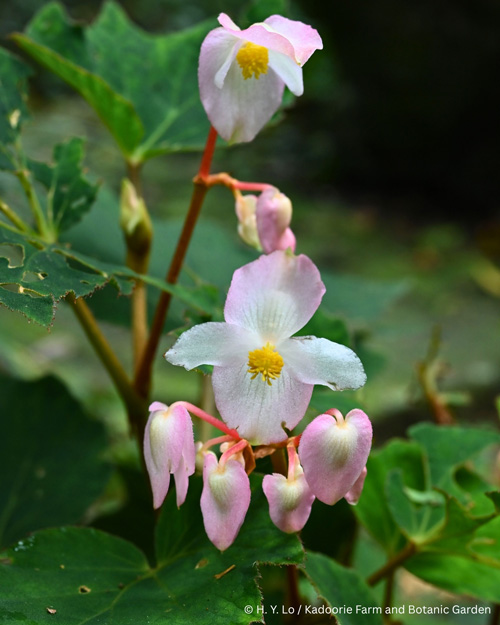Hong Kong's Natural Treasures: Seven Remarkable Plant Species at KFBG
At Kadoorie Farm and Botanic Garden (KFBG), we are proud to grow, conserve, display and restore many of Hong Kong’s characteristic, native plant species. Our combined scientific and horticultural approach extends to numerous rare and threatened species that are representative of the rich biodiversity of our region. In this blog post, we highlight seven remarkable plant species that you can discover during your visit to KFBG, each of them flowering and fruiting at different times of the year.
Long-eared Dog Orchid (Bulbophyllum bicolor)Flowering period: April to May In nature, the Long-eared Dog Orchid grows both as an epiphyte (that is, attached to the surface of another plant, usually the trunk or branches of a tree) and as a lithophyte (directly attached to a rock or cliff). Feared extinct in Vietnam and Laos, the species is presently only known to persist in Hong Kong and nearby parts of South China (Guangdong and Guangxi Province), with an estimated total of fewer than 20 populations remaining in the wild. As a result, it is classified as Critically Endangered globally. The species is threatened by collection, illegal trade and habitat degradation, which have together brought about population decline, fragmentation and the loss of genetic diversity. Research at KFBG has revealed that the Long-eared Dog Orchid depends upon a specific species of Diptera fly to transfer pollen between two genetically distinct individuals for successful pollination and the production of seeds. Owing to this specialised ecology, the probability of reproduction occurring within any of Hong Kong’s small, isolated and genetically impoverished populations is practically zero. To overcome this sorry situation, KFBG’s ecologists have hand-pollinated genetically distinct plants in their care and raised the resulting seeds in the lab to produce a new generation of healthy, diverse offspring. These plants are now being reintroduced back into the wild to prevent further decline and possible extinction. Seedlings of the Long-eared Dog Orchid – the fruits of this labour – have been established at several places within KFBG, including the Walter Kerr Garden and Orchid Haven. Visit these places in early summer to observe this incredible species and icon for Hong Kong plant conservation up close! |
Chinese Chirita (Primulina dryas)Flowering period: May to February The Chinese Chirita thrives in humid conditions and is typically found resplendent on damp cliffs and large, mossy rocks in streams and ravines throughout Hong Kong and parts of Guangdong. Its purple, trumpet-shaped flowers unfailingly attract the attention of adventurous hikers in the wild as well as curious visitors to KFBG’s Walter Kerr Garden and Orchid Haven. The tubular part of the flower, technically referred to as the corolla tube, is formed of the fused petals and encloses two fertile stamens. The lowermost petal features two vibrant yellow stripes that attract and guide bees into the throat of the flower, thereby facilitating pollination. This species is easily propagated. Besides cultivation from seed, it can also be propagated from leaf cuttings. The species belongs to the Gesneriaceae family, which contains the African violets and many other lovely plants of high ornamental value. As a result, Chinese Chirita may seem familiar – indeed, it and its relatives are popularly grown in pots, gardens and glasshouses around the world. |
Hong Kong Lady’s Slipper Orchid (Paphiopedilum purpuratum)Flowering period: October to January This beautiful if other-worldly plant grows in dappled sunlight on forested slopes and in moist, humus-rich, rocky crevices close to streams. It is only found in parts of southeast China and northern Vietnam. When the northeast monsoon winds begin to blow, the Hong Kong Slipper Orchid produces an erect, hairy stalk that bears a single flower made up of a striking white-and-purple striped fan-like dorsal sepal, a pair of warty, horizontally spreading petals and a deep pouch that looks like an upside-down helmet. The epithet ‘purpuratum’ in its scientific name refers to its deep purple colouration, while its Chinese name translates as ‘purple-veined pouch orchid’. It is Hong Kong’s only native slipper orchid, a member of the tropical Asian genus Paphiopedilum, which comprises around 80 species distributed from India and southern China to the Malay Archipelago and New Guinea. Patient observation of blooming plants in the wild has revealed that the yellowish-green shield-shaped staminode (a sterile stamen) at the centre of the flower and the dark purple warts on the petals mimic aphid colonies. Female hoverflies seeking a meal for their larvae are duly attracted to the flowers in the mistaken belief they have found somewhere suitable to lay their eggs. In this process, the unwitting hoverfly slips into the pouch, which is lined with numerous minute, downward-pointing hairs that thwart the poor fly’s escape. Eventually she will find the only route out: one of two openings at the rear of the staminode that forces her to push past the orchid’s sticky pollen masses. The pollen is smeared onto the fly’s body as she exits. If she makes the same mistake again and visits another flower, she assists the orchid with cross-pollination by depositing her payload of pollen onto the stigma of the second plant: a truly ingenious though devious mechanism that only wastes the fly’s time and energy! Due to illegal collection of these magnificent plants and destruction of their fragile habitat, wild populations of Paphiopedilum purpuratum have declined substantially. Unfortunately, the species remains a target of poachers right here in Hong Kong. It is listed as Critically Endangered by the International Union for Conservation of Nature. |
Ford’s Manglietia (Magnolia fordiana)Flowering period: May
Ford’s Manglietia is a large, evergreen tree that is native to central and southern China and northern Vietnam. In Hong Kong, it grows in remote ravines, generally at high elevation. During its flowering season, it produces attractive, bulbous, creamy-white flowers at the tips of its branches. The species belongs to the botanical family Magnoliaceae, which is considered to be a primitive representative of flowering plants. As such, understanding of its ecology and taxonomy contributes to a fuller picture of the evolution of all plants. Its Chinese name relates to its characteristic features within this ancient plant lineage. Close examination of Magnolia flowers reveals that they possess six or more tepals, rather than clearly differentiated sepals and petals, and that the stamens and pistils are embedded in a central, conical receptacle in spiral formation. Another distinctive feature of the family is the ring-like stipular scars that are visible on the branches. These scars form when the stipules, which protect new leaves, fall away. Each scar therefore marks the position where a new leaf developed. Wild specimens of Ford’s Manglietia can reach heights of up to 20–25 metres, making them one of Hong Kong’s large native trees. After pollination, the pistil clusters develop into brownish follicles. Due to its rarity, the government of Hong Kong SAR lists Ford’s Manglietia in its reference book Rare and Precious Plants of Hong Kong. In fact, all members of the Magnoliaceae family are protected under Chapter 96 of the Forests and Countryside Ordinance and its Regulations. |
Birdwood’s Mucuna (Mucuna birdwoodiana)Flowering period: Late February to early April
Birdwood’s Mucuna is a climbing plant that is characterised by its distinctive bunches of hanging flowers, each one resembling a miniature sparrow, from which the plant gets its Chinese common name, which translates as ‘Java Sparrow Flower’. Its hefty, woody stems are rooted into the ground but clamber up and over trunks and boughs, spreading from one tree crown to the next. During its flowering season, numerous inflorescences burst forth from the stems, producing a spectacular display of hundreds of pale yellowish-green blossoms dangling at various heights beneath the canopy. Their day-glow tone and pungent smell attract various wild animals. In fact, this vine exhibits a fascinating ecological relationship with several charismatic mammals. Pallas’s Squirrels (Callosciurus erythraeus), Rhesus Macaques (Macaca mulatta) and Masked Palm Civets (Paguma larvata) all come in search of the flowers’ rich supply of nectar. Deftly climbing along the vine’s stems to access mature flowers, these animals pull and probe to try and get at the sugary reward hidden behind a clever series of barriers formed by the tightly fused petals. Only if pressure is exerted with the right force in the right place will the petals spring apart, allowing access to the nectar at the base of the flower and catapulting pollen onto the snout of the foraging animal in the process. As the animal proceeds to the next bunch of flowers, it carries the powdery pollen with it, inadvertently depositing it onto the stigma of the next flower it successfully opens – thereby facilitating pollination. The fair exchange of a nectar payment for this vital service highlights this as a mutualistic relationship in which both plant and animal benefit. Intriguingly, however, research at KFBG has revealed that not all visitors are equal when it comes to fulfilling this pact. Rhesus Macaques are good at tearing the inflorescences off the plant and ripping the flowers apart to get at the nectar inside, damaging the vine and precluding fruit-set. Only the Masked Palm Civets and, to an extent, the Pallas’s Squirrels are patient and tactile enough to carefully prize open the petals and leave the flowers in place to bring about effective pollination. An enormous Birdwood’s Mucuna can be found just behind the Art House in the Walter Kerr Garden. Visitors should note that the yellowish-brown hairs covering the base of the flowers and seed pods may cause skin irritation upon contact, so observation should be conducted without physically handling them. Simply gaze up and be awestruck by pondering how this incredible interaction evolved and the multiple ways in which the vine supports the ecology of the forests in which it grows. |
Holey Hainanese Amydrium (Amydrium hainanense)Flowering Period: September to December
According to botanical records, Hong Kong supports over 2,300 native plant species – a jaw-dropping number given the territory’s compact size. Even more amazingly, every year this number grows as botanists continue to explore and document the local flora. In 2021, KFBG botanists confirmed the Holey Hainanese Amydrium as a new record for Hong Kong after its discovery on Lantau Island by a local schoolteacher and amateur botanist several years before. The species was first described by botanists from the island of Hainan in 1979. The Holey Hainanese Amydrium grows as a self-clinging vine that attaches its rope-like stems to tree trunks with the aid of adhesive aerial roots. It belongs to Araceae, the aroid family, which also contains Taro (Calocasia esculenta) and the Titan Arum (Amorphophallus titanum). One of the distinguishing features of the plant is its ovate, waxy-green leaves with irregular perforations. After KFBG staff visited the site on Lantau to take photographs of the entire plant, its leaves, flowers and fruits, voucher specimens were collected for formal identification and as evidence of the species’ occurrence here. These voucher specimens allowed the identity of the plant to be confirmed and are now permanently preserved in KFBG’s herbarium, serving as an important scientific record and a milestone in Hong Kong’s ongoing journey of botanical discovery. |
Cut-leaved Begonia (Begonia palmata)Flowering Period: June to August
Well known for its attractive foliage and bright pink and orange flowers, the genus Begonia is enormously popular in the potted plant and garden trade. Comprising over 2000 species, it is one of the world’s largest genera of flowering plants, with members occurring in tropical and subtropical parts of Central and South America, Africa and Asia. In China alone there are in excess of 200 native species, many of them confined to particular regions or mountain ranges. The Cut-leaved Begonia grows naturally across southern China as well as in neighbouring countries of the Indo-Burma region. It is one of five native Begonia species found in Hong Kong, where it grows in a range of habitats, from the shaded forest understorey to relatively open hillsides, though generally at higher elevation. It prefers moist sites and in ideal conditions can become quite abundant. One of the striking features of the species in Hong Kong is the great range in variation in colour exhibited by its leaves. Whereas most plants have uniformly dark green leaves, some are mottled with patches of lighter green or silver, and yet others have patches of deep maroon. Plants bloom through the summer months, with each flower containing either female or male parts, and the perianth segments varying in colour from sharp pink to white. Attaining up to 60 cm or more in height and bristling with a dense covering of short, red or tawny hairs on the stems and leaf stalks, a stand of this multicoloured herb can be quite a sight to behold when encountered on a wooded hillside. The specific epithet ‘palmata’ in its scientific name refers to the ‘palm-shaped’ leaves, while its Chinese name relates to the leaves’ irregular divisions. |
We invite you to visit Kadoorie Farm and Botanic Garden throughout the year to observe these remarkable species in their various flowering seasons. By understanding and appreciating Hong Kong's native plant diversity, we can all contribute to protecting these natural treasures for future generations.



.jpg)
.jpg)
.jpg)


